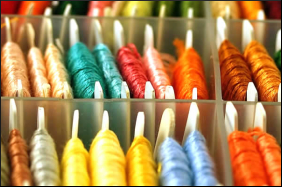|

|
'Duty-free access to B'deshi goods to hit textile industry'
|
|

|
|
| Top Stories |
 |
|
|
|
Namrata Kath Hazarika | 22 Sep, 2011
India's recent decision to allow duty-free access to Bangladeshi textile goods has left the domestic textile industry in a great shock, as this move would adversely affect the investment in complete textile value chain, said the Confederation of Indian Textile Industry (CITI), Secretary General, D.K Nair.
He told SME Times, "Exports of garments from Bangladesh is considerably larger than ours, since they have considerably lower labour cost and workable labour laws. Allowing zero duty access to Bangladesh for practically all garments, as has been done, can eat into our domestic garment industry's market first and then that of the fabrics and yarn industries as well."
"With vulnarable handloom, power loom and decentralised knitting accounting for most of fabric production and 75% of our garment industry is in the SME sector, the problems for our textile sector will be tremendous." Nair said.
The government will remove 61 items, including 48 readymade garments, from the list of protected goods that India has maintained under South Asia Free Trade Agreement (SAFTA).
Further, the CITI has also taken up the matter with the Prime Minister, Manmohan Singh, seeking potential relief to the sector. In a recent letter written to the PM, CITI chief, Shishir Jaipuria, said, "We are aware of the general approach of government to use trade policy as a tool for achieving geo-political objectives. In our view, such a policy decision needs an assessment of the likely perilous consequences on the domestic garment manufacturing and loss of employment, which the sector generates especially for unskilled female workers."
CITI also added, "The 45 HS lines for which Bangladesh is seeking zero duty access in our market cover most of their total garment production in terms of quantity. The products for which they have sought concessions are also major products for our domestic production as well as
consumption."
He added that if the government provides quota-free access to Bangladsh, this will naturally affect the fate of 35 million workers and a large number of Small and Medium Enterprises (SMEs) engaged in production of textiles and garments in India is at stake on this issue. There will be severe adverse impact on the garment clusters in Tirupur, Ludhiana and West Bengal.
In fact, the cheap labour is the major advantage for the textile industry in Bangladesh as compared to India, Jaipuria said.
Further, he suggested that policy decision of allowing of duty free quota garment imports from Bangladesh in India should not be taken in haste and recommended to set up a committee of experts (COE) from various textile research associations and experts like SITRA, NITRA, ICRIER and the government and industry’s representatives may be formed to examine the various consequences of such decision.
"Based on the reports of Committee of Experts, government may deliberate upon the possibilities of tweaking with the existing policy. Till that time, any policy decision leading to change in current status quo should be kept in abeyance." he added.
If the government decides to go further with it then it is important that it (government) should at least think to save India's textile segment consisting of weaving, knitting and spinning by making a precondition that the Origin of Fabrics will be Indian alone, CITI said.
"We are well aware that Bangladesh is dependent upon China for Fabric Supplies and this access will therefore indirectly give access to Chinese textile to Indian market through Bangladesh," it added further.
India’s apparel exports increased by about 5% CAGR from $8.63 bn in 2005-06 to $12.5 bn in 2010-11 against 18% growth recorded by Bangladesh’s garment exports during the same period.Bangladesh’s garment exports increased from $7.9 bn in 2005-06 to $17.92 bn in 2010-11 and would cross $25bn target set by Bangladesh within next 3 years.
|
|
|
| |
|
|
|
|
|
|
|
|
|
|
|
|
|
|
| |
| Customs Exchange Rates |
| Currency |
Import |
Export |
US Dollar
|
66.20
|
64.50 |
UK Pound
|
87.50
|
84.65 |
Euro
|
78.25
|
75.65 |
| Japanese
Yen |
58.85 |
56.85 |
| As on 13 Aug, 2022 |
|
|
| Daily Poll |
 |
 |
| PM Modi's recent US visit to redefine India-US bilateral relations |
|
|
|
|
|
| Commented Stories |
 |
|
|
|
|
|
| |
|